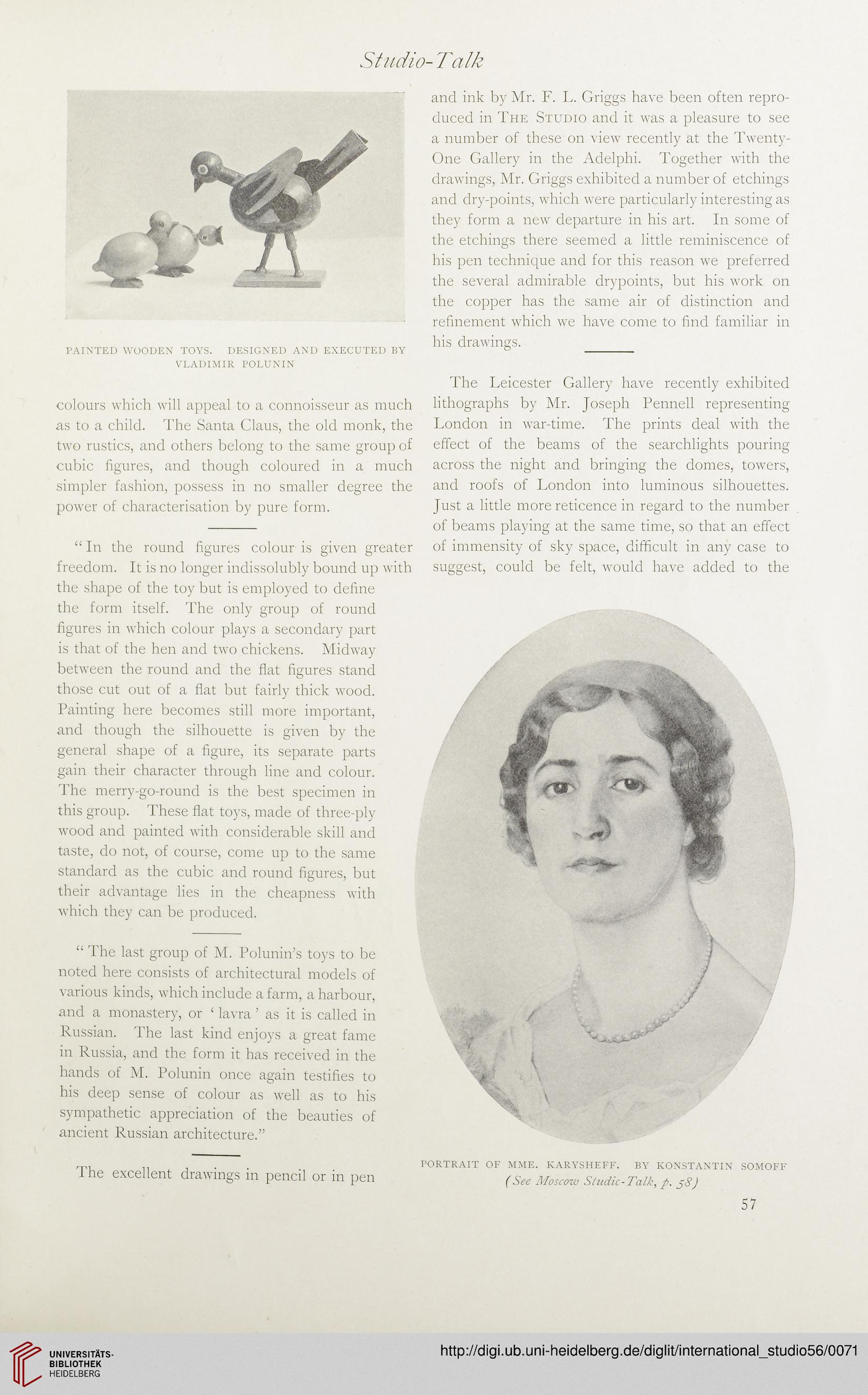Studio-Talk
PAINTED WOODEN TOYS. DESIGNED AND EXECUTED BY
VLADIMIR POLUNIN
colours which will appeal to a connoisseur as much
as to a child. The Santa Claus, the old monk, the
two rustics, and others belong to the same group of
cubic figures, and though coloured in a much
simpler fashion, possess in no smaller degree the
power of characterisation by pure form.
“ In the round figures colour is given greater
freedom. It is no longer indissolubly bound up with
the shape of the toy but is employed to define
the form itself. The only group of round
figures in which colour plays a secondary part
is that of the hen and two chickens. Midway
between the round and the flat figures stand
those cut out of a flat but fairly thick wood.
Painting here becomes still more important,
and though the silhouette is given by the
general shape of a figure, its separate parts
gain their character through line and colour.
The merry-go-round is the best specimen in
this group. These flat toys, made of three-ply
wood and painted with considerable skill and
taste, do not, of course, come up to the same
standard as the cubic and round figures, but
their advantage lies in the cheapness with
which they can be produced.
“ The last group of M. Polunin’s toys to be
noted here consists of architectural models of
various kinds, which include a farm, a harbour,
and a monastery, or ‘ lavra ’ as it is called in
Russian. The last kind enjoys a great fame
in Russia, and the form it has received in the
hands of M. Polunin once again testifies to
his deep sense of colour as well as to his
sympathetic appreciation of the beauties of
ancient Russian architecture.”
The excellent drawings in pencil or in pen
and ink by Mr. F. L. Griggs have been often repro-
duced in The Studio and it was a pleasure to see
a number of these on view recently at the Twenty-
One Gallery in the Adelphi. Together with the
drawings, Mr. Griggs exhibited a number of etchings
and dry-points, which were particularly interesting as
they form a new departure in his art. In some of
the etchings there seemed a little reminiscence of
his pen technique and for this reason we preferred
the several admirable drypoints, but his work on
the copper has the same air of distinction and
refinement which we have come to find familiar in
his drawings. _
The Leicester Gallery have recently exhibited
lithographs by Mr. Joseph Pennell representing
London in war-time. The prints deal with the
effect of the beams of the searchlights pouring
across the night and bringing the domes, towers,
and roofs of London into luminous silhouettes.
Just a little more reticence in regard to the number
of beams playing at the same time, so that an effect
of immensity of sky space, difficult in any case to
suggest, could be felt, would have added to the
57
PAINTED WOODEN TOYS. DESIGNED AND EXECUTED BY
VLADIMIR POLUNIN
colours which will appeal to a connoisseur as much
as to a child. The Santa Claus, the old monk, the
two rustics, and others belong to the same group of
cubic figures, and though coloured in a much
simpler fashion, possess in no smaller degree the
power of characterisation by pure form.
“ In the round figures colour is given greater
freedom. It is no longer indissolubly bound up with
the shape of the toy but is employed to define
the form itself. The only group of round
figures in which colour plays a secondary part
is that of the hen and two chickens. Midway
between the round and the flat figures stand
those cut out of a flat but fairly thick wood.
Painting here becomes still more important,
and though the silhouette is given by the
general shape of a figure, its separate parts
gain their character through line and colour.
The merry-go-round is the best specimen in
this group. These flat toys, made of three-ply
wood and painted with considerable skill and
taste, do not, of course, come up to the same
standard as the cubic and round figures, but
their advantage lies in the cheapness with
which they can be produced.
“ The last group of M. Polunin’s toys to be
noted here consists of architectural models of
various kinds, which include a farm, a harbour,
and a monastery, or ‘ lavra ’ as it is called in
Russian. The last kind enjoys a great fame
in Russia, and the form it has received in the
hands of M. Polunin once again testifies to
his deep sense of colour as well as to his
sympathetic appreciation of the beauties of
ancient Russian architecture.”
The excellent drawings in pencil or in pen
and ink by Mr. F. L. Griggs have been often repro-
duced in The Studio and it was a pleasure to see
a number of these on view recently at the Twenty-
One Gallery in the Adelphi. Together with the
drawings, Mr. Griggs exhibited a number of etchings
and dry-points, which were particularly interesting as
they form a new departure in his art. In some of
the etchings there seemed a little reminiscence of
his pen technique and for this reason we preferred
the several admirable drypoints, but his work on
the copper has the same air of distinction and
refinement which we have come to find familiar in
his drawings. _
The Leicester Gallery have recently exhibited
lithographs by Mr. Joseph Pennell representing
London in war-time. The prints deal with the
effect of the beams of the searchlights pouring
across the night and bringing the domes, towers,
and roofs of London into luminous silhouettes.
Just a little more reticence in regard to the number
of beams playing at the same time, so that an effect
of immensity of sky space, difficult in any case to
suggest, could be felt, would have added to the
57




